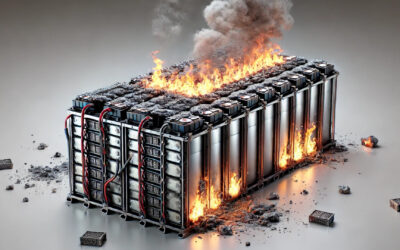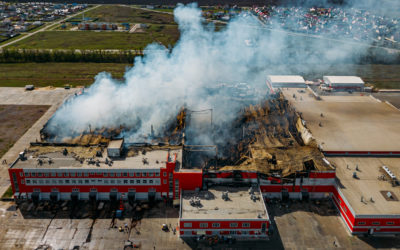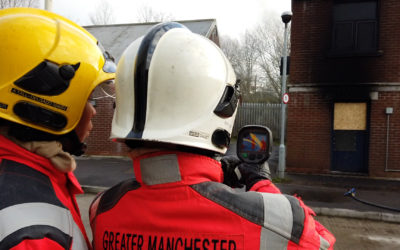Cobra used on fire in an electric vehicle.
Conventional car fires (with internal combustion engines) are incidents that the fire services have dealt with for many years. Therefore, there is a great deal of knowledge in this area, and it usually takes no more than five minutes to extinguish such a fire. The car market is growing. Modern cars can be powered by various alternative fuels: diesel, petrol, ethanol, CNG (compressed natural gas), LNG (liquid natural gas) or LPG (liquid petroleum gas). There are also a growing number of electric cars on the road, including both hybrid electric vehicles and 100% battery electric vehicles. (1)
This Use Case focuses on extinguishing Li-ion battery fires in electric vehicles. Li-ion batteries are currently the most common battery type used in the traction batteries of EVs, and they have gained a notorious, perhaps undeserved, reputation for their propensity to burn. Although the likelihood of a battery cell inside a traction battery overheating and going into thermal runaway is low, it is still possible. A battery cell that is in thermal runaway may, through heat transfer to nearby battery cells, create a propagation – whereby multiple battery cells reach thermal runaway. When thermal runaway and propagation occur, there are two ways to end the propagation: 1, Cool the battery internally (2), or 2, Let the battery burn until the energy is consumed.
In the event of an Electric Vehicle Fire
Consider that the traction battery is not always involved in the fire. An electric vehicle fire should initially always be handled in the same way as a fire in a conventional vehicle – where the interior such as textiles and plastics account for a large part of the fire load.
Preparation & planning
A general plan should be set up and practised to prepare for intervention in Li-ion traction batteries. The plan should cover known risks, resources and methods/tactics.
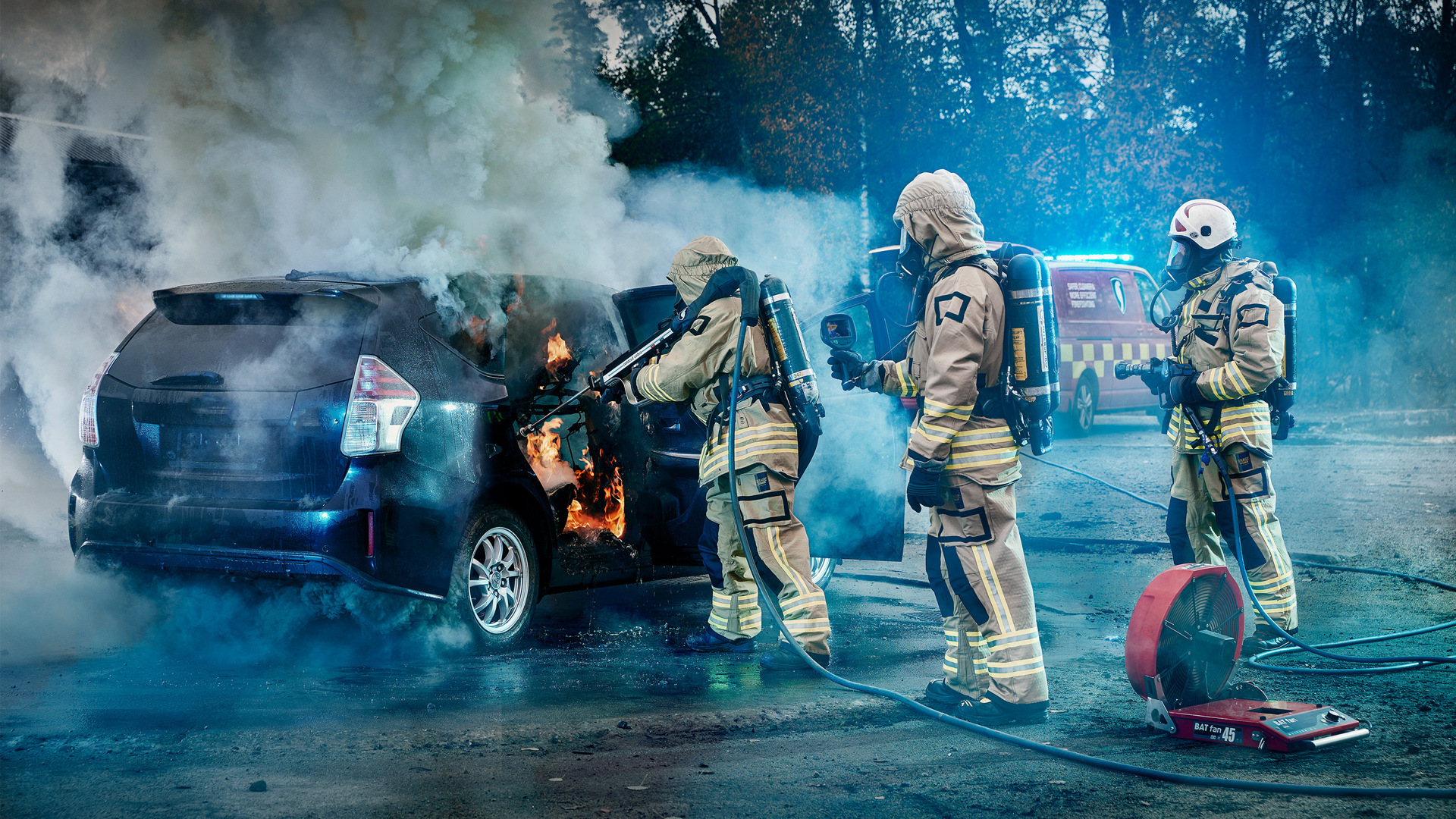
Risk handling
The risk management and choice of action need to be adapted based on the situation facing the crews. The evaluation of the risks involved in handling an EV battery with thermal runaway includes:
Determine whether the traction battery is involved in the fire
One priority is to determine whether the traction battery is in thermal runaway and the thermal runaway is propagating. Information on this could be gained from the vehicle’s control system by using a thermal imaging camera (TIC) or by using your senses – sight (smoke), sound (popping noise) and smell (distinct odour, like acetone). To be able to use a TIC, it might be necessary to extinguish the fire in the vehicle’s compartment or to open a closed compartment. Before such actions are taken, however, you must consider the other risk-reducing measures, below.
Protection of assets
Traction battery fires may go on for a long time. If possible, it might be a good idea to move the vehicle to a safe spot to protect other vehicles or properties.
Electrocution
Even though the risk of electrocution is very small, simple measures should be taken to further minimise the risks. These measures are unplugging AC charging connectors, and preventing operators from becoming a part of the traction battery’s circuit by short-circuiting the traction battery. To become part of a circuit, the operator must connect to both the battery’s positive and negative poles with two different body parts.
Explosion
Risks of explosion or deflagration in a contained volume should be minimised – identify contained smoke and neutralise (cool, wash, ventilate, etc.). If the vehicle compartment is ventilated and there are open flames, the risk of deflagration is minimised.
Toxic smoke
All fires generate toxic smoke to some degree. Plan to protect operators and assets by tactical ventilation.
Jet flames from the traction battery
As thermal runaway propagates, sudden energy release might cause jet flames. Our tests indicate that it is possible to predict jet flames from a burning traction battery by studying the jet flames that emerge. The battery is equipped with venting exhausts, and the jet flames use these as a path of least resistance. Once identified, find working positions away from the venting exhausts.
Stranded energy
Once the thermal runaway is deemed to have reached a steady state, operators and other personnel should be aware of the possibility of re-ignition, which may even occur a long time after the initial fire. Therefore, if moved, the involved vehicle should be monitored cautiously.
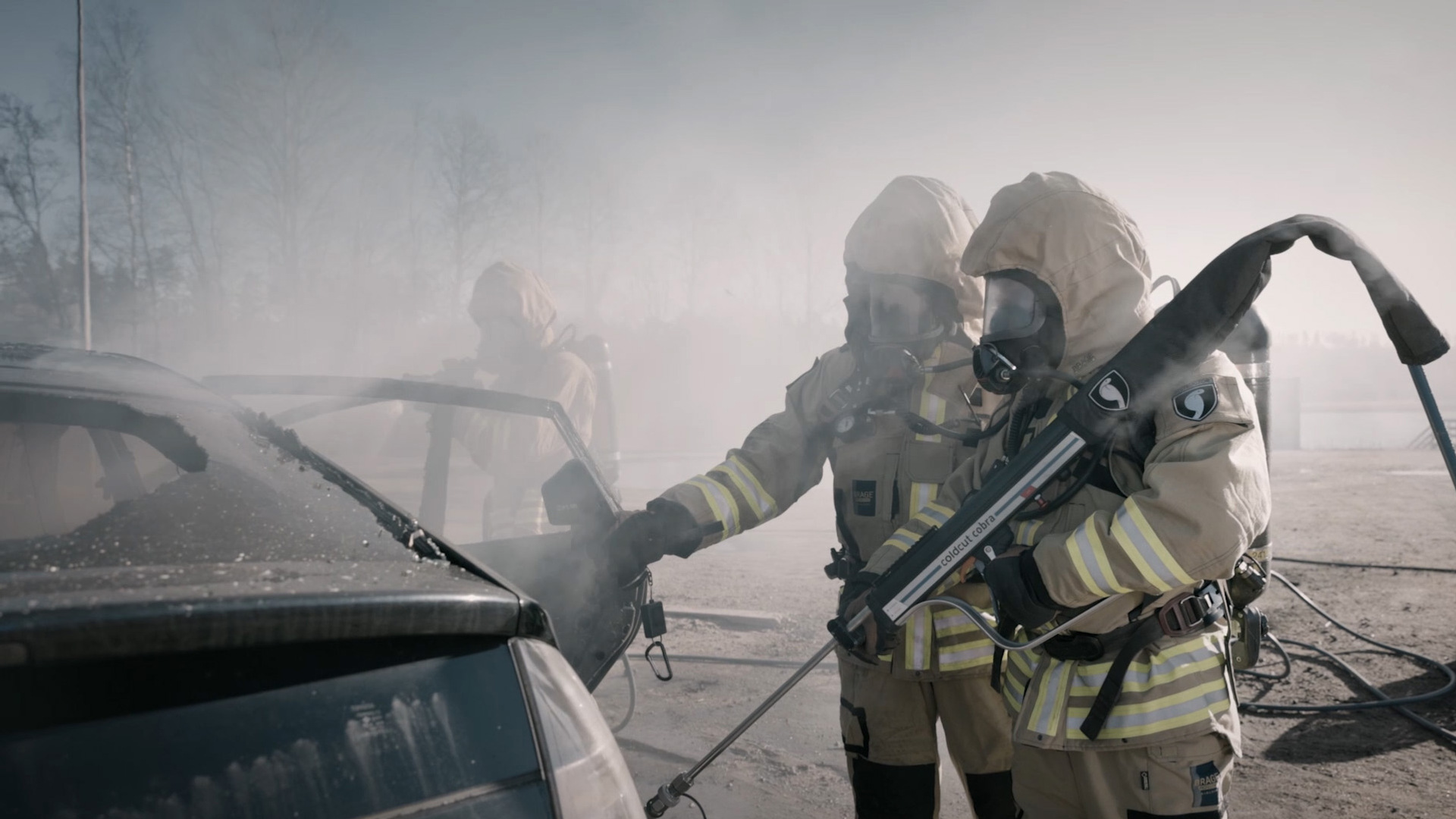
Resources
The resources needed will depend on the situation and the fire service’s guidelines. Here is a suggestion of roles that are required in order to intervene with a single-battery EV fire in a low-risk environment. The same firefighter can perform more than one role.
Roles
- Incident Commander – decision-maker finds safe spot for Cobra Operator
- Cobra Operator – operates the hand lance on command
- Cobra Second – uses the thermal imaging camera to identify hot spots of the traction battery (could be same crew as Incident Commander)
- Branch Operator – operates hose to extinguish the interior and exterior of the vehicle. Once this is done, they will protect the Cobra Operator.
- Driver – places and operates PPV to fan smoke away from Cobra Operator, and monitors supply levels essential for the intervention.
Equipment & supply
- Breathing apparatus (BA) and personal protective equipment (PPE) for crew
- Cobra system with lance extension
- One hose
- Thermal imaging camera (TIC)
- Positive pressure ventilation (PPV)
- Equipment according to local regulations
Intervention tactics
In the case of a confirmed fire involving the traction battery, it is important to determine the geometry of the battery. This information is available in the vehicle type-specific Rescue Sheet and the associated Emergency Response Guide. This data is most easily accessed via the Euro Rescue application, which was developed by NCAP in cooperation with CTIF. (3) When approaching, make sure not to touch or connect with the vehicle at two different locations to avoid becoming a part of the traction battery’s circuit. The car fire must initially be extinguished in the same way as for a conventional car fire. Set up the resources accordingly before intervention. Be aware of fire gas smoke that may be contained inside the vehicle’s compartment – use Cobra through the chassis (not windows) to cool fire gases and to minimise the risk of deflagration before allowing air to access the contained compartment. While extinguishing a fire in the vehicle’s interior and exterior, monitor where jet flames are exiting in order to find a safe position for the Cobra Operator.
Use a thermal imaging camera to find hotspots
If the battery is involved, look for hotspots to establish a Cobra attack point. When Cobra is deployed, an additional active water source should be present, whose primary task is to knock down flames that endanger the Cobra Operator. It is important that the Cobra Operator is patient and remains at the point of attack in order to create a flow of cooling water that finds its way through the battery pack. Although the battery pack may be challenging to reach, Cobra can be used from any angle. In addition, the lance extender can be attached to optimise the attack – an excellent way to access the battery pack from outside the car.
Throughout the operation, the progress is monitored by the TIC – the aim of the Cobra attack is to cool the traction battery to below 50°C and to ensure the temperature remains stable. Only once a steady temperature in the traction battery has been reached can the propagation be considered to have been stopped and the Cobra attack completed. Continued extinguishing of the car fire should be performed if necessary – continued thermal camera monitoring of the traction battery is essential for at least 15 minutes. The operation can be assessed as completed when the car is extinguished and the propagation has stopped.
Limited amount of water
Cobra allows quick and easy access and can be repositioned if results are not achieved. In addition, Cobra uses only 30 to 60 litres of water per minute, saving the environment from needless runoff water. Using a traditional branch not only requires the use of large amounts of water, but this use of large amounts of water is also recommended. One car manufacturer recommends a water supply of 3,000 US gallons (>11,000 litres) to cool a traction battery in one of their car models. (4) UL Fire Safety Research Institute tests indicate that it is practically impossible to stop the propagation until the entire battery pack is burnt out by introducing water to the exterior of an enclosed battery pack. (5)
Communication
As in most operations, communication is vital. The Cobra operator may need help to see the effect Cobra is having, and good communication between the crew, the Cobra operator and Incident Commander is essential to ensure the Cobra lance is used in the best position. In addition, knowledge of the battery’s geometry and position will enable the operator to achieve the best effect.
With knowledge and training, EV battery fires can be controlled. Watch the film below summarising the method of extinguishing EV battery fires with Cobra.
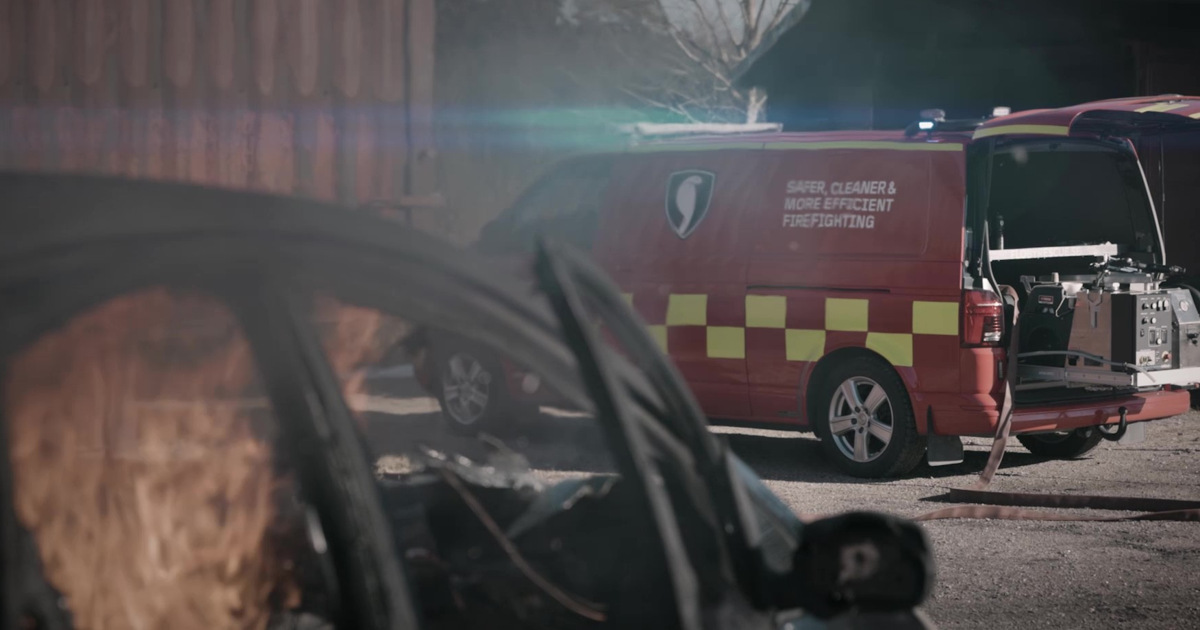
Cobra benefits
Limits damage from water
When fighting propagation in Li-ion batteries, traditional firefighting methods use a considerable amount of water – 450 litres or more per minute – and can significantly damage the surrounding environment. Cobra uses considerably less water than traditional firefighting methods.
Limits water use
Cobra uses just 60 litres of water per minute, so a 1,800-litre water tank will last for 30 minutes, if Cobra is used continuously.
Dynamic use
It is easy to move the lance to where it is needed. Cobra can be used whatever the position of the vehicle. All parts of the vehicle can be accessed.
Ergonomic
With the correct training, the lance is easy to use.
Multidimensional tool
Cobra is a multidimensional firefighting tool that can be used in a wide range of different fire scenarios.
Cobra can be fitted into a range of different vehicles
Cobra can be adopted for use by fire and rescue services, private fire brigades and company firefighting response teams.
Training
The Cold Cut Academy can provide full training in the safe and effective use of Cobra in a range of scenarios including EV/Li-ion battery fires. All training is delivered by highly experienced current, or former, operational firefighters.
Benefits of Cobra use
- Limits damage from water
- Limits water use
- Dynamic use
- Ergonomic
- Multidimensional tool
- Can be fitted into a range of different vehicles
- Training opportunities
Sources:
(1) https://msverige.se/allt-om-bilen/miljo/bilar-och-branslen/
(2) Demonstration av släckmetod för litiumjonbatterier. Metodtillämpning på olika aggregationsnivåer – modul, sub-batteri, elbilspack och fordonsnivå, (2023), Myndigheten för samhällsskydd och beredskap (MSB)
(3) https://www.euroncap.com/en/press-media/press-releases/euro-ncap-improves-tertiary-safety-by-introducing-a-mobile-app-for-first-responders-in-europe/
(4) Emergency Response Guide for Tesla Model S Since 2016, dated 2019 and read through Euro Rescue App on March 2nd, 2023
(5) See “Suppressing of Flaming Thermal Runaway” section in course “The Science of Fire and Explosion Hazards from Li-Ion Batteries” at https://training.fsri.org/ (visited February 2023)
